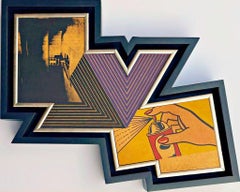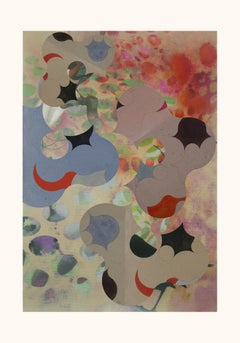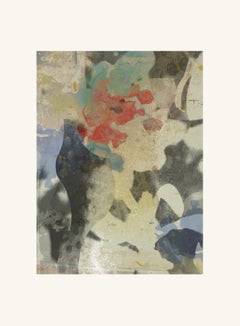Richard Pettibone Mixed Media
American, b. 1938
Richard Pettibone (American, b.1938) is one of the pioneering artists to use appropriation techniques. Pettibone was born in Los Angeles, and first worked with shadow boxes and assemblages, illustrating his interest in craft, construction, and working in miniature scales.(Biography provided by ArtWise)
to
1
1
1
1
1
Overall Height
to
Overall Width
to
1
1
1
4
472
268
213
207
1
1
1
1
1
Artist: Richard Pettibone
The Appropriation piece: Andy Warhol, Frank Stella, Roy Lichtenstein Unique var.
By Richard Pettibone
Located in New York, NY
Richard Pettibone
The Appropriation Print Andy Warhol, Frank Stella, Roy Lichtenstein, 1970
Silkscreen in colors on masonite board (unique variant on sculpted board)
Hand-signed by artist, Signed and dated on the front (see close up image)
Bespoke frame Included
This is a rare example of Pettibone's iconic Appropriation Print, as it's silkscreened and sculpted on masonite board rather than paper, giving it a different background hue, and enabling it work to be framed so uniquely.
The Appropriation print is one of the most coveted prints Pettibone ever created ; the regular edition is on a full sheet with white background; the present example was silkscreened on board, allowing it to be framed in 3-D. While we do not know how many examples of this graphic work Pettibone created, so far the present work is the only one example we have ever seen on the public market since 1970. (Other editions of The Appropriation Print have been printed on vellum, wove paper and pink and yellow paper.)
This 1970 homage to Andy Warhol, Frank Stella and Roy Lichtenstein exemplifies the type of artistic appropriation he was engaging in early on during the height of the Pop Art movement - long before more contemporary artists like Deborah Kass, Louise Lawler, etc. followed suit.
This silkscreen was in its original 1970 vintage period frame; a bespoke custom hand cut black wood outer frame was subsequently created especially to house the work, giving it a distinctive sculptural aesthetic.
Measurements:
Framed 14.5 inches vertical by 18 inches horizontal by 2 inches
Work
13 inches vertical by 16.5 inches horizontal
Richard Pettibone biography:
Richard Pettibone (American, b.1938) is one of the pioneering artists to use appropriation techniques. Pettibone was born in Los Angeles, and first worked with shadow boxes and assemblages, illustrating his interest in craft, construction, and working in miniature scales. In 1964, he created the first of his appropriated pieces, two tiny painted “replicas” of the iconic Campbell’s soup cans by Andy Warhol (American, 1928–1987). By 1965, he had created several “replicas” of paintings by American artists, such as Warhol, Roy Lichtenstein (1923–1997), Ed Ruscha (b.1937), and others, among them some of the biggest names in Pop Art. Pettibone chose to recreate the work of leading avant-garde artists whose careers were often centered on themes of replication themselves, further lending irony to his work. Pettibone also created both miniature and life-sized sculptural works, including an exact copy of Bicycle Wheel by Marcel Duchamp (French, 1887–1968), and in the 1980s, an entire series of sculptures of varying sizes replicating the most famous works of Constantin Brancusi (Romanian, 1876–1957). In more recent years, Pettibone has created paintings based on the covers of poetry books by Ezra Pound, as well as sculptures drawn from the grid compositions of Piet Mondrian (Dutch, 1872–1944). Pettibone straddles the lines of appropriation, Pop, and Conceptual Art, and has received critical attention for decades for the important questions his work raises about authorship, craftsmanship, and the original in art. His work has been exhibited at the Institute for Contemporary Art in Philadelphia, the Museum of Modern Art in New York, the Museum of Contemporary Art in Miami, and the Laguna Art Museum in Laguna Beach, CA. Pettibone is currently based in New York.
"I wished I had stuck with the idea of just painting the same
painting like the soup can and never painting another painting.
When someone wanted one, you would just do another one.
Does anybody do that now?"
Andy Warhol, 1981
Since the mid-1960s, Richard Pettibone has been making
hand-painted, small-scale copies of works by other artists — a
practice due to which he is best known as a precursor of appropriation art — and for a decade now, he has been revisiting subjects from across his career. In his latest exhibitions at
Castelli Gallery, Pettibone has been showing more of the “same”
paintings that had already been part of his 2005–6 museum retrospective,1
and also including “new” subject matter drawn from
his usual roster of European modernists and American postwar
artists. Art critic Kim Levin laid out some phases of the intricate spectrum from copies to repetitions in her review of the
Warhol-de Chirico showdown, a joint exhibition at the heyday
of appropriation art in the mid-1980s when Warhol’s appropriations of de Chirico’s work effectively revaluated “the grand
old auto-appropriator”.
Upon having counted well over a dozen
Disquieting Muses by de Chirico, Levin speculated: “Maybe he
kept doing them because no one got the point. Maybe he needed the money. Maybe he meant it when he said his technique
had improved, and traditional skills were what mattered.”
On
the other side, Warhol, in her eyes, was the “latter-day exemplar
of museless creativity”.
To Pettibone, traditional skills certainly
still matter, as he practices his contemporary version of museless creativity. He paints the same painting again and again,
no matter whether anybody shows an interest in it or not. His
work, of course, takes place well outside the historical framework of what Levin aptly referred to as the “modern/postmodern wrestling match”,
but neither was this exactly his match
to begin with.
Pettibone is one of appropriation art’s trailblazers, but his diverse
selection of sources removes from his work the critique of the
modernist myth of originality most commonly associated with
appropriation art in a narrow sense, as we see, for example, in
Sherrie Levine’s practice of re-photographing the work of Walker
Evans and Edward Weston. In particular, during his photorealist
phase of the 1970s, Pettibone’s sources ranged widely across
several art-historical periods. His appropriations of the 1980s
and 1990s spanned from Picasso etchings and Brancusi sculptures to Shaker furniture and even included Ezra Pound’s poetry.
Pettibone has professed outright admiration for his source artists, whose work he shrinks and tweaks to comic effect but, nevertheless, always treats with reverence and care. His response
to these artists is primarily on an aesthetic level, owing much
to the fact that his process relies on photographs. By the same
token, the aesthetic that attracts him is a graphic one that lends
itself to reproduction. Painstakingly copying other artists’ work by hand has been a way of making
it his own, yet each source is acknowledged in
his titles and, occasionally, in captions on white
margins that he leaves around the image as an
indication that the actual source is a photographic image. The enjoyment he receives in copying
is part of the motivation behind doing it, as is
the pleasure he receives from actually being with
the finished painting — a considerable private
dimension of his work. His copies are “handmade
readymades” that he meticulously paints in great quantities in his studio upstate in New York; the commitment
to manual labor and the time spent at material production has
become an increasingly important dimension of his recent work.
Pettibone operates at some remove from the contemporary art
scene, not only by staying put geographically, but also by refusing to recoup the simulated lack of originality through the
creation of a public persona.
In so doing, Pettibone takes a real
risk. He places himself in opposition to conceptualism, and he is
apprehensive of an understanding of art as the mere illustration
of an idea. His reading of Marcel Duchamp’s works as beautiful
is revealing about Pettibone’s priorities in this respect.
When
Pettibone, for aesthetic pleasure, paints Duchamp’s Poster...
Category
1970s Pop Art Richard Pettibone Mixed Media
Materials
Masonite, Pencil, Screen, Mixed Media
Related Items
ST107B-Contemporary, Abstract prints, stil-life, figurative, nude, landscape
By Francisco Nicolás
Located in London, London
Edition of 25
Digital pigment print Ultrachrome ink on Fabriano Rosaspina paper. Hand signed by the artist, and certificate of authenticity, (Unframed)
His work has been shown in...
Category
2010s Pop Art Richard Pettibone Mixed Media
Materials
Archival Pigment, Paper, Mixed Media, C Print, Color, Digital Pigment
H 27.56 in W 19.69 in D 0.4 in
ST1b99-Contemporary, Abstract prints, stil-life, figurative, nude, landscape
By Francisco Nicolás
Located in London, London
Flowers 09, 2019
Edition of 25
Digital pigment print Ultrachrome ink on Fabriano Rosaspina paper. Hand signed by the artist, and certificate of authenticity, (Unframed)
His work h...
Category
2010s Pop Art Richard Pettibone Mixed Media
Materials
Paper, Mixed Media, C Print, Inkjet, Giclée, Pigment, Archival Pigment
H 27.56 in W 19.69 in D 0.4 in
HEART II Signed Hand Colored Lithograph, Love Symbol, Red, Yellow, Turquoise
By Peter Max
Located in Union City, NJ
HEART II - is a unique, hand colored lithograph by the pop culture icon - Peter Max. The image Heart II was printed in 1981 as a limited edition lithograph of 165, using traditional...
Category
1980s Pop Art Richard Pettibone Mixed Media
Materials
Mixed Media, Lithograph
ST1a58-Contemporary , Abstract, Gestual, Street art, Pop art, Modern, Geometric
By Francisco Nicolás
Located in London, London
Black & Flowers, 2019
Edition of 25
Digital pigment print Ultrachrome ink on Fabriano Rosaspina paper. Hand signed by the artist, and certificate of authenticity, (Unframed)
His w...
Category
2010s Pop Art Richard Pettibone Mixed Media
Materials
Archival Pigment
H 37.41 in W 27.56 in D 0.4 in
Reel, mixed media, 4 x 6 inches. Purple abstract print
By Karin Bruckner
Located in New York, NY
Mixed Media on Paper
Inked Mylar scorched and fused
On white BFK Rives Printmaking Paper
w/ Pencil and Metal Leaf
Edition : Unique
Category
2010s Contemporary Richard Pettibone Mixed Media
Materials
Metal
1963 Pop Art Mixed Media Silkscreen on Pillowcase Neon Colors Stephen Antonakos
By Stephen Antonakos
Located in Surfside, FL
DREAM
New York City, USA
Provenance: Charles Byron Gallery, [1965]
Silkscreen on linen pillowcase
Hand signed. this is not numbered. (it says on gallery label verso edition of 100, I do not know how many were actually made)
This is from an early-1960s series of pillows that married cloth, text, metal (including plumbing pipes and nails) and other found objects. The last pillow in the series incorporated the word “DREAM” in neon letters.
Stephen Antonakos (Greek: Στυλιανός Αντωνάκος) born in 1926 in Agios Nikolaos, Laconia, Greece – died in 2013 in New York City. Antonakos moved with his family from Greece to the United States at the age of 4 and was raised in the Brooklyn, New York neighborhood of Bay Ridge.
Antonakos' work has been included in several important international exhibitions including Documenta 6 in 1977 in Kassel, Germany and he represented Greece at the Venice Biennale in 1997. Anatonakos’s long career, characterized by his creation of brightly colored light installations. Works like Arrival (2008) and Neon Table #1 (1986) have a kinship with the works of Dan Flavin, and the 1960s Light and Space movement of Southern California that included Larry Bell, Bruce Nauman, and Doug Wheeler...
Category
1960s Pop Art Richard Pettibone Mixed Media
Materials
Fabric, Acrylic
Still, mixed media, 4 x 6 inches. Abstract printmaking
By Karin Bruckner
Located in New York, NY
Mixed Media on Paper
Inked Mylar scorched and fused
On white BFK Rives Printmaking Paper
w/ Pencil and Metal Leaf
Edition : Unique
Category
2010s Contemporary Richard Pettibone Mixed Media
Materials
Metal
Bags
Located in Santa Monica, CA
Silkscreen/Collage on Retail Bags
Category
21st Century and Contemporary Pop Art Richard Pettibone Mixed Media
Materials
Screen
ST1c58-Contemporary , Abstract, Gestual, Street art, Pop art, Modern, Geometric
By Francisco Nicolás
Located in London, London
Voluptuosidad II, 2019
Edition of 25
Digital pigment print Ultrachrome ink on Fabriano Rosaspina paper. Hand signed by the artist, and certificate of authenticity, (Unframed)
His ...
Category
2010s Pop Art Richard Pettibone Mixed Media
Materials
Archival Pigment
H 37.41 in W 27.56 in D 0.4 in
flower18-Contemporary , Abstract, Gestual, Street art, Pop art, Modern, Geometric
By Francisco Nicolás
Located in London, London
Flowers VIII, 2019
Edition of 25
Digital pigment print Ultrachrome ink on Fabriano Rosaspina paper. Hand signed by the artist, and certificate of authenticity, (Unframed)
His work...
Category
2010s Pop Art Richard Pettibone Mixed Media
Materials
Archival Pigment
H 27.56 in W 18.9 in D 0.4 in
Dedication–Lincoln Center (B.App.23)
By Robert Motherwell
Located in London, GB
44.5 x 29.25 ins (113 x 74.3 cms)
Edition of 108
Signature:Signed "R. Motherwell" in pencil lower left
Inscriptions:Numbered in pencil lower left; some impressions have artist's chop mark lower left
Publisher:The Juilliard School...
Category
1960s Abstract Expressionist Richard Pettibone Mixed Media
Materials
Color, Mixed Media, Screen
ST1ca8-Gestual, Street art, Pop art, Modern, Contemporary, Abstract , Geometric
By Francisco Nicolás
Located in London, London
Calma y voluptuosidad VII, 2019
Edition of 25
Digital pigment print Ultrachrome ink on Fabriano Rosaspina paper. Hand signed by the artist, and certificate of authenticity, (Unfram...
Category
2010s Pop Art Richard Pettibone Mixed Media
Materials
Archival Pigment
H 27.56 in W 19.69 in D 0.4 in
Richard Pettibone mixed media for sale on 1stDibs.
Find a wide variety of authentic Richard Pettibone mixed media available for sale on 1stDibs. You can also browse by medium to find art by Richard Pettibone in masonite, mixed media, pencil and more. Much of the original work by this artist or collective was created during the 1970s and is mostly associated with the Pop Art style. Not every interior allows for large Richard Pettibone mixed media, so small editions measuring 18 inches across are available. Customers who are interested in this artist might also find the work of Jean-Michel Basquiat, Larry Rivers, and Robert Indiana. Richard Pettibone mixed media prices can differ depending upon medium, time period and other attributes. On 1stDibs, the price for these items starts at $15,000 and tops out at $15,000, while the average work can sell for $15,000.


